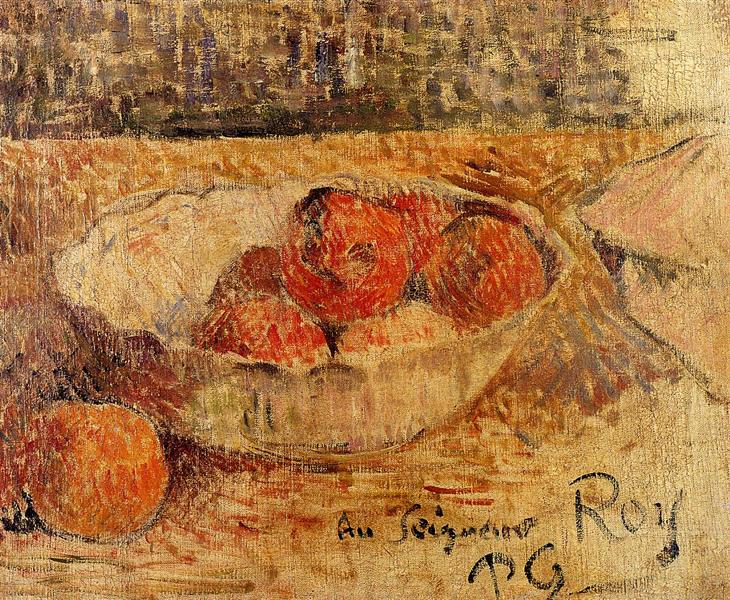Description
Paul Gauguin's painting "Fruit in a Bowl", created in 1886, reflects the artist's quest to move away from the conventions of academic art and explore an aesthetic that combined vibrant colors, simplified forms, and an almost symbolic approach to nature. Representative of his period of experimentation in composition and color, this work evokes an essence of everyday life through a simple yet evocative arrangement of fruit.
At the centre of the composition, a rounded bowl holds a variety of fruits arranged in remarkable harmony. The colour of the fruits is an unmistakable feature of Gauguin’s style, which uses a rich palette of warm and contrasting tones. The fruits are saturated in colour: the yellows and oranges of the oranges and lemons shine against the background, while the greens of the avocado contrast with the warm tones of the bowl that holds it, creating a dialogue of colours that breathes life into the work. This exuberant use of colour is characteristic of Post-Impressionism, of which Gauguin is one of the leading exponents.
The attention to detail on the surface of the fruits is notable, displaying the textures and nuances of each of the elements. However, it is the stylized treatment of these forms that really enhances their uniqueness. Rather than simply imitating the reality of the fruits, Gauguin captures them through an almost decorative approach, where geometry and saturation play a primary role. This is a precursor to what he would develop later in his work, particularly during his stay in Tahiti, where the fusion between natural elements and symbolic representation becomes more marked.
As in many of his works, the weight of symbolism can be seen here as well. The bowl of fruit can be interpreted as a reference to abundance, but also to the fragility of life itself. In this way, the painting invites contemplation beyond the surface, suggesting a philosophical background that Gauguin would begin to develop in his later works. However, this work lacks human characters, which reveals a central interest in the elements of nature and in the representation of domestic life through objects that, although everyday, are treated with aesthetic reverence.
Gauguin, who always sought a deeper and more meaningful form of expression, uses this work to explore an intense connection with nature. “Fruit in a Bowl” sits on a transitional path towards a more personal and symbolic artistic language that would ultimately define his practice. The use of light and shadow, although simplified, gives depth to the bowl and its contents, reinforcing the notion of space and the three-dimensionality of the object on a two-dimensional canvas.
The work is framed at a significant moment in Gauguin's career, who had already begun to distance himself from the expectations of his time. The influence of Impressionism is evident, but his path towards a unique and daring style that he would pursue in his later works is visible. "Fruit in a Bowl" can be seen as a study of the essence of the everyday, a testimony to the artistic genius that is already in search of a meaning beyond what is observed. With this painting, Gauguin invites us to appreciate the intrinsic beauty in the simplest objects, thus revealing the depth of art in the exploration of human experience.
KUADROS ©, a famous painting on your wall.
Hand-made oil painting reproductions, with the quality of professional artists and the distinctive seal of KUADROS ©.
Painting reproduction service with satisfaction guarantee. If you are not completely satisfied with the replica of your painting, we will refund 100% of your money.

